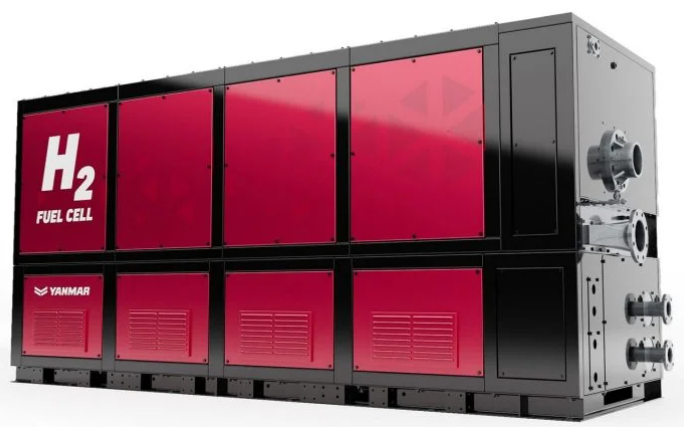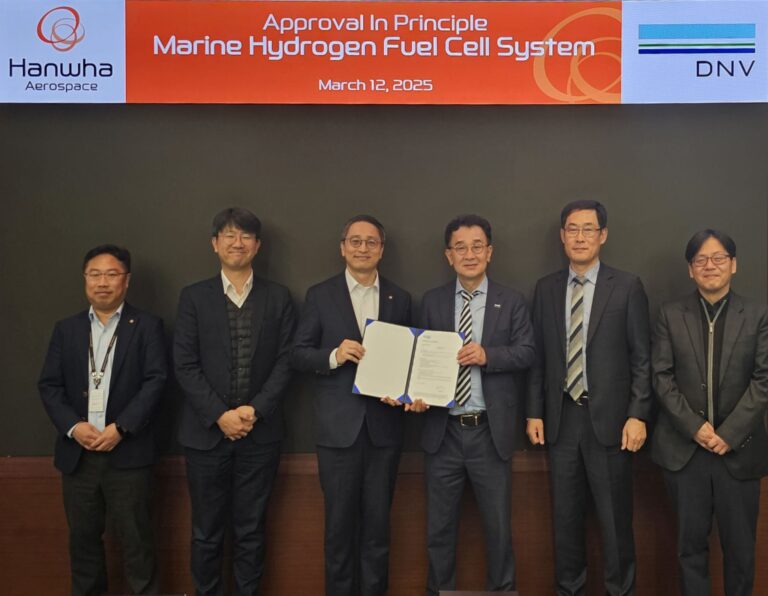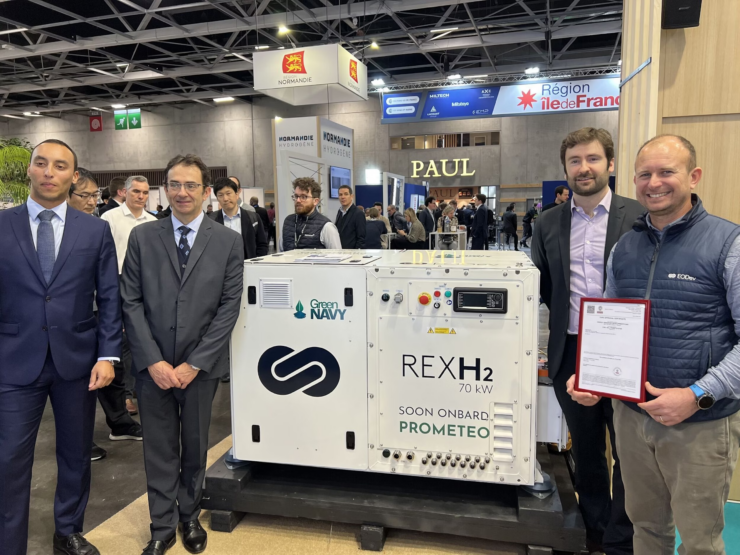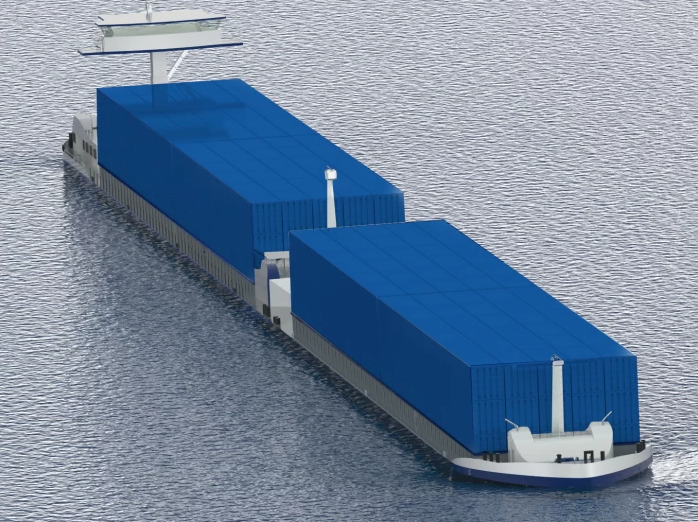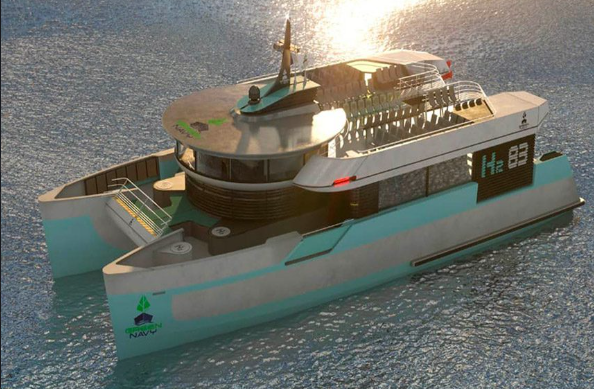Over the last months several fuel cells have reached approval milestones from classification societies. This is very encouraging to see as this clear a large hurdle to maritime applications. This article compares the LT-PEM fuel cells currently available for maritime use.
LT-PEM fuel cells
Hydrogen fuel cells are becoming the go-to technology for zero-emission maritime propulsion. Among these, low-temperature proton exchange membrane (LT-PEM) fuel cells are particularly suited to shipping. They’re compact, modular, and efficient.
Below table gives an overview of the relevant fuel cells for maritime applications.
| Manufacturer | Model | Rated Power | Dimensions (L×W×H) | Inlet Hydrogen Pressure | Class Approval | Commercial Use Status | Notable Projects |
| Ballard Power (Canada) | FCwave™ | 200 kW (modular) | 1209×741×2195 mm | 3.5–6.5 bar(g) | DNV, LR, ABS (Type Approval) | In operation | Norled MF Hydra, H₂ Barge 2, Zulu06 |
| Vinssen (S. Korea) | 60 kW Stack (120 kW system) | 60 kW per stack (120 kW system) | Compact (N/A) | Low-pressure (N/A) | RINA (Type Approval) | Approved, demo ongoing | Vinssen demo vessel, KR AiP tug |
| Hanwha Aerospace (S. Korea) | 200 kW Marine PEMFC | 200 kW | N/A (prototype) | 5–7 bar (expected) | DNV/KR (AiP) | AiP granted, not yet deployed | Integration with Hanwha Ocean |
| TECO 2030 (Norway) | FCM400 | 400 kW per module | Containerized (N/A) | 5–8 bar | DNV (AiP) | AiP granted | HyEkoTank, ZEAS projects |
| PowerCell Sweden | Marine System 225 | 225 kW | 1200×900×2000 mm | 3–8 bar(g) | DNV/LR compliance (pending Type Approval) | Deliveries underway | Italian shipbuilder, cruise ships |
| Nedstack PemGen 300 (Netherlands) | PemGen® 300 | ~825 kW (3×275 kW) | Installed in vessel hold (N/A) | 0.3–6 bar(g) | Lloyd’s Register | In operation | H₂ Barge 1 (Rotterdam-Antwerp) |
| Nedstack PemGen 600 (Netherlands) | PemGen® 600 | 600 kW (740 kW peak) | 6060×2440×2900 mm (20′ container) | 0.3–6 bar(g) | BV (AiP) | AiP granted | Available for inland/coastal vessels |
| Cummins/Hydrogenics (USA) | Hydrogenics HD | 360 kW total | Installed onboard (N/A) | Regulated from 350 bar | US Coast Guard approved | In operation | Sea Change ferry (California) |
| EODev (France) | REXH₂® | 70 kW per module | 1710×1060×1020 mm | 5–7 bar(g) | BV (Type Approval) | Type Approved, deployments upcoming | PROMETEO catamaran, Energy Observer |
| Corvus Energy (Norway) | Pelican Fuel Cell | 340 kW (4×85 kW) | 2160×1427×2320 mm | 5.4–14 bar(g) | DNV (Type Approval) | Type Approved, prototype phase | Short-sea vessels, ferries (planned) |
| EH-Group (Swiss) | EH TRACE-M250 | 250 kW | Compact (N/A) | Low-pressure (N/A) | DNV (AiP) | AiP granted | Maritime applications |
| Genevos (France) | HPM-250 | 250 kW | 1400×800×1800 mm | >2.5 bar(a) | BV (AiP) | AiP granted | Nordics ferry project, workboats |
Let’s take a closer look at some of the leading LT-PEM hydrogen fuel cell solutions available for maritime applications.
Proven and In-Service Solutions
Several manufacturers already have fuel cells operating commercially at sea.
Ballard Power Systems leads with its FCwave™, a 200 kW module scalable to megawatt levels. The FCwave™ received type approval from DNV, Lloyd’s Register, and ABS. It’s in active use aboard vessels like the Norled MF Hydra, the world’s first liquid hydrogen ferry. Other deployments include H₂ Barge 2 and the Zulu06 inland vessel.
Nedstack from the Netherlands offers the PemGen® 300, delivering around 825 kW through multiple stacks. It powers the H₂ Barge 1, an inland container vessel servicing Rotterdam and Antwerp since 2023. Nedstack’s modular approach provides flexibility for retrofitting existing vessels. After running in financial difficulties in 2024 Nedstack was taken over by German Freudenberg.
Cummins (Hydrogenics), with its 360 kW system, powers the Sea Change ferry in California. The system secured approval from the U.S. Coast Guard, highlighting its reliability for passenger transport.
Fuel Cells with Type Approvals
Other fuel cell systems have gained recent class approvals, signaling readiness for commercial deployment.
South Korea’s Vinssen earned RINA type approval in 2025 for its 60 kW stacks (assembled into 120 kW systems). Vinssen’s systems are ideal for smaller vessels, harbor tugs, and ferries. A demonstration vessel is already underway.
Norway’s Corvus Energy developed the 340 kW Pelican fuel cell pack, based on Toyota modules. It achieved DNV type approval in 2024. Corvus targets short-sea shipping and ferries, promising rapid adoption in Northern Europe.
France’s EODev secured Bureau Veritas type approval for its modular 70 kW REXH₂® unit. The system’s first marine installation is set for the PROMETEO catamaran, emphasizing flexibility and scalability.
Systems Nearing Commercial Deployment
Other players hold Approval in Principle (AiP) from classification societies, signaling they’re close to commercial rollout.
Hanwha Aerospace from South Korea holds AiP from DNV and Korean Register for its 200 kW marine PEMFC. Hanwha targets larger commercial vessels and integration with ammonia-to-hydrogen solutions.
TECO 2030 of Norway has DNV AiP for its powerful 400 kW FCM400 module. Unfortunately current status of this development is unclear due to the filing for bankruptcy of the company.
PowerCell Sweden developed the Marine System 225, optimized at 225 kW per module. Already selected for cruise ships and commercial orders, full type approval is expected soon.
Genevos from France has an AiP for its compact 250 kW HPM-250. Its modular design suits smaller workboats, ferries, and offshore vessels.
EH-Group from Swiss has an AiP from DNV for the 250 kW EH-Trace-M250 unit since 2024. The unit has a high power density which makes it well-suited for multi-MW applications.
Why It Matters
LT-PEM fuel cells are a critical piece of maritime decarbonization. With type approvals and commercial projects expanding, these systems offer proven, certified solutions. Shipowners can now confidently adopt hydrogen propulsion technology.
In the coming years, expect rapid growth in zero-emission maritime vessels. LT-PEM fuel cells are leading this charge, delivering reliable, scalable, and emission-free energy at sea.
